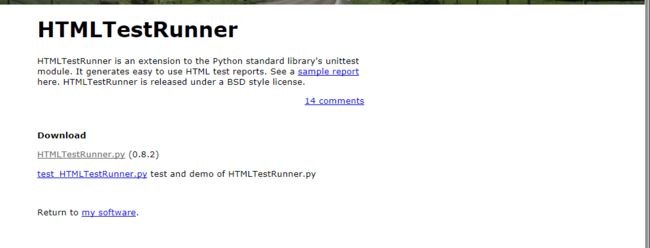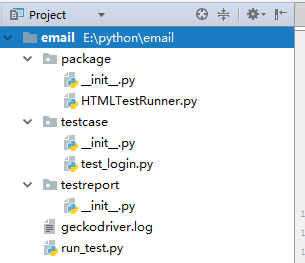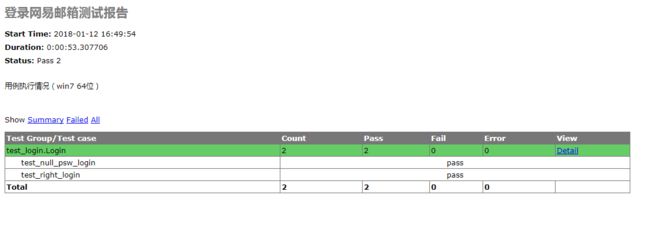【Python自动化测试】如何才能让用例自动运行完之后,生成一张直观可看易懂的测试报告呢?
小编使用的是unittest的一个扩展HTMLTestRunner
- 环境准备
使用之前,我们需要下载HTMLTestRunner.py文件
点击HTMLTestRunner后进入的是一个写满代码的网页,小编推荐操作:右键 --> 另存为,文件名称千万不要改
python3使用上述HTMLTestRunner可能会报错,可以替换如下文件
-
""" -
A TestRunner for use with the Python unit testing framework. It -
generates a HTML report to show the result at a glance. -
The simplest way to use this is to invoke its main method. E.g. -
import unittest -
import HTMLTestRunner -
... define your tests ... -
if __name__ == '__main__': -
HTMLTestRunner.main() -
For more customization options, instantiates a HTMLTestRunner object. -
HTMLTestRunner is a counterpart to unittest's TextTestRunner. E.g. -
# output to a file -
fp = file('my_report.html', 'wb') -
runner = HTMLTestRunner.HTMLTestRunner( -
stream=fp, -
title='My unit test', -
description='This demonstrates the report output by HTMLTestRunner.' -
) -
# Use an external stylesheet. -
# See the Template_mixin class for more customizable options -
runner.STYLESHEET_TMPL = '' -
# run the test -
runner.run(my_test_suite) -
------------------------------------------------------------------------ -
Copyright (c) 2004-2007, Wai Yip Tung -
All rights reserved. -
Redistribution and use in source and binary forms, with or without -
modification, are permitted provided that the following conditions are -
met: -
* Redistributions of source code must retain the above copyright notice, -
this list of conditions and the following disclaimer. -
* Redistributions in binary form must reproduce the above copyright -
notice, this list of conditions and the following disclaimer in the -
documentation and/or other materials provided with the distribution. -
* Neither the name Wai Yip Tung nor the names of its contributors may be -
used to endorse or promote products derived from this software without -
specific prior written permission. -
THIS SOFTWARE IS PROVIDED BY THE COPYRIGHT HOLDERS AND CONTRIBUTORS "AS -
IS" AND ANY EXPRESS OR IMPLIED WARRANTIES, INCLUDING, BUT NOT LIMITED -
TO, THE IMPLIED WARRANTIES OF MERCHANTABILITY AND FITNESS FOR A -
PARTICULAR PURPOSE ARE DISCLAIMED. IN NO EVENT SHALL THE COPYRIGHT OWNER -
OR CONTRIBUTORS BE LIABLE FOR ANY DIRECT, INDIRECT, INCIDENTAL, SPECIAL, -
EXEMPLARY, OR CONSEQUENTIAL DAMAGES (INCLUDING, BUT NOT LIMITED TO, -
PROCUREMENT OF SUBSTITUTE GOODS OR SERVICES; LOSS OF USE, DATA, OR -
PROFITS; OR BUSINESS INTERRUPTION) HOWEVER CAUSED AND ON ANY THEORY OF -
LIABILITY, WHETHER IN CONTRACT, STRICT LIABILITY, OR TORT (INCLUDING -
NEGLIGENCE OR OTHERWISE) ARISING IN ANY WAY OUT OF THE USE OF THIS -
SOFTWARE, EVEN IF ADVISED OF THE POSSIBILITY OF SUCH DAMAGE. -
""" -
# URL: http://tungwaiyip.info/software/HTMLTestRunner.html -
__author__ = "Wai Yip Tung" -
__version__ = "0.8.2" -
""" -
Change History -
Version 0.8.2 -
* Show output inline instead of popup window (Viorel Lupu). -
Version in 0.8.1 -
* Validated XHTML (Wolfgang Borgert). -
* Added description of test classes and test cases. -
Version in 0.8.0 -
* Define Template_mixin class for customization. -
* Workaround a IE 6 bug that it does not treat -
%(heading)s -
%(report)s -
%(ending)s -
-
-
""" -
# variables: (title, generator, stylesheet, heading, report, ending) -
# ------------------------------------------------------------------------ -
# Stylesheet -
# -
# alternatively use a for external style sheet, e.g. -
# -
STYLESHEET_TMPL = """ -
-
""" -
# ------------------------------------------------------------------------ -
# Heading -
# -
HEADING_TMPL = """ -
%(title)s -
%(parameters)s -
%(description)s -
""" # variables: (title, parameters, description)
HEADING_ATTRIBUTE_TMPL = """
%(name)s: %(value)s
""" # variables: (name, value)
# ------------------------------------------------------------------------
# Report
#
REPORT_TMPL = """
Show
%(test_list)s
| Test Group/Test case | Count | Pass | Fail | Error | View |
| Total | %(count)s | %(Pass)s | %(fail)s | %(error)s |
""" # variables: (test_list, count, Pass, fail, error)
REPORT_CLASS_TMPL = r"""
%(desc)s
%(count)s
%(Pass)s
%(fail)s
%(error)s
""" # variables: (style, desc, count, Pass, fail, error, cid)
REPORT_TEST_WITH_OUTPUT_TMPL = r"""
%(desc)s%(script)s
""" # variables: (tid, Class, style, desc, status)
REPORT_TEST_NO_OUTPUT_TMPL = r"""
%(desc)s%(status)s
""" # variables: (tid, Class, style, desc, status)
REPORT_TEST_OUTPUT_TMPL = r"""
%(id)s: %(output)s
""" # variables: (id, output)
# ------------------------------------------------------------------------
# ENDING
#
ENDING_TMPL = """
""" # -------------------- The end of the Template class -------------------
TestResult = unittest.TestResult
class _TestResult(TestResult):
# note: _TestResult is a pure representation of results.
# It lacks the output and reporting ability compares to unittest._TextTestResult.
def __init__(self, verbosity=1):
TestResult.__init__(self)
self.stdout0 = None
self.stderr0 = None
self.success_count = 0
self.failure_count = 0
self.error_count = 0
self.verbosity = verbosity
# result is a list of result in 4 tuple
# (
# result code (0: success; 1: fail; 2: error),
# TestCase object,
# Test output (byte string),
# stack trace,
# )
self.result = []
def startTest(self, test):
TestResult.startTest(self, test)
# just one buffer for both stdout and stderr
self.outputBuffer = io.StringIO()
stdout_redirector.fp = self.outputBuffer
stderr_redirector.fp = self.outputBuffer
self.stdout0 = sys.stdout
self.stderr0 = sys.stderr
sys.stdout = stdout_redirector
sys.stderr = stderr_redirector
def complete_output(self):
"""
Disconnect output redirection and return buffer.
Safe to call multiple times.
"""
if self.stdout0:
sys.stdout = self.stdout0
sys.stderr = self.stderr0
self.stdout0 = None
self.stderr0 = None
return self.outputBuffer.getvalue()
def stopTest(self, test):
# Usually one of addSuccess, addError or addFailure would have been called.
# But there are some path in unittest that would bypass this.
# We must disconnect stdout in stopTest(), which is guaranteed to be called.
self.complete_output()
def addSuccess(self, test):
self.success_count += 1
TestResult.addSuccess(self, test)
output = self.complete_output()
self.result.append((0, test, output, ''))
if self.verbosity > 1:
sys.stderr.write('ok ')
sys.stderr.write(str(test))
sys.stderr.write('\n')
else:
sys.stderr.write('.')
def addError(self, test, err):
self.error_count += 1
TestResult.addError(self, test, err)
_, _exc_str = self.errors[-1]
output = self.complete_output()
self.result.append((2, test, output, _exc_str))
if self.verbosity > 1:
sys.stderr.write('E ')
sys.stderr.write(str(test))
sys.stderr.write('\n')
else:
sys.stderr.write('E')
def addFailure(self, test, err):
self.failure_count += 1
TestResult.addFailure(self, test, err)
_, _exc_str = self.failures[-1]
output = self.complete_output()
self.result.append((1, test, output, _exc_str))
if self.verbosity > 1:
sys.stderr.write('F ')
sys.stderr.write(str(test))
sys.stderr.write('\n')
else:
sys.stderr.write('F')
class HTMLTestRunner(Template_mixin):
"""
"""
def __init__(self, stream=sys.stdout, verbosity=1, title=None, description=None):
self.stream = stream
self.verbosity = verbosity
if title is None:
self.title = self.DEFAULT_TITLE
else:
self.title = title
if description is None:
self.description = self.DEFAULT_DESCRIPTION
else:
self.description = description
self.startTime = datetime.datetime.now()
def run(self, test):
"Run the given test case or test suite."
result = _TestResult(self.verbosity)
test(result)
self.stopTime = datetime.datetime.now()
self.generateReport(test, result)
# print >> sys.stderr, '\nTime Elapsed: %s' % (self.stopTime-self.startTime)
print(sys.stderr, '\nTime Elapsed: %s' % (self.stopTime-self.startTime))
return result
def sortResult(self, result_list):
# unittest does not seems to run in any particular order.
# Here at least we want to group them together by class.
rmap = {}
classes = []
for n,t,o,e in result_list:
cls = t.__class__
if not cls in rmap:
rmap[cls] = []
classes.append(cls)
rmap[cls].append((n,t,o,e))
r = [(cls, rmap[cls]) for cls in classes]
return r
def getReportAttributes(self, result):
"""
Return report attributes as a list of (name, value).
Override this to add custom attributes.
"""
startTime = str(self.startTime)[:19]
duration = str(self.stopTime - self.startTime)
status = []
if result.success_count: status.append('Pass %s' % result.success_count)
if result.failure_count: status.append('Failure %s' % result.failure_count)
if result.error_count: status.append('Error %s' % result.error_count )
if status:
status = ' '.join(status)
else:
status = 'none'
return [
('Start Time', startTime),
('Duration', duration),
('Status', status),
]
def generateReport(self, test, result):
report_attrs = self.getReportAttributes(result)
generator = 'HTMLTestRunner %s' % __version__
stylesheet = self._generate_stylesheet()
heading = self._generate_heading(report_attrs)
report = self._generate_report(result)
ending = self._generate_ending()
output = self.HTML_TMPL % dict(
title = saxutils.escape(self.title),
generator = generator,
stylesheet = stylesheet,
heading = heading,
report = report,
ending = ending,
)
self.stream.write(output.encode('utf8'))
def _generate_stylesheet(self):
return self.STYLESHEET_TMPL
def _generate_heading(self, report_attrs):
a_lines = []
for name, value in report_attrs:
line = self.HEADING_ATTRIBUTE_TMPL % dict(
name = saxutils.escape(name),
value = saxutils.escape(value),
)
a_lines.append(line)
heading = self.HEADING_TMPL % dict(
title = saxutils.escape(self.title),
parameters = ''.join(a_lines),
description = saxutils.escape(self.description),
)
return heading
def _generate_report(self, result):
rows = []
sortedResult = self.sortResult(result.result)
for cid, (cls, cls_results) in enumerate(sortedResult):
# subtotal for a class
np = nf = ne = 0
for n,t,o,e in cls_results:
if n == 0: np += 1
elif n == 1: nf += 1
else: ne += 1
# format class description
if cls.__module__ == "__main__":
name = cls.__name__
else:
name = "%s.%s" % (cls.__module__, cls.__name__)
doc = cls.__doc__ and cls.__doc__.split("\n")[0] or ""
desc = doc and '%s: %s' % (name, doc) or name
row = self.REPORT_CLASS_TMPL % dict(
style = ne > 0 and 'errorClass' or nf > 0 and 'failClass' or 'passClass',
desc = desc,
count = np+nf+ne,
Pass = np,
fail = nf,
error = ne,
cid = 'c%s' % (cid+1),
)
rows.append(row)
for tid, (n,t,o,e) in enumerate(cls_results):
self._generate_report_test(rows, cid, tid, n, t, o, e)
report = self.REPORT_TMPL % dict(
test_list = ''.join(rows),
count = str(result.success_count+result.failure_count+result.error_count),
Pass = str(result.success_count),
fail = str(result.failure_count),
error = str(result.error_count),
)
return report
def _generate_report_test(self, rows, cid, tid, n, t, o, e):
# e.g. 'pt1.1', 'ft1.1', etc
has_output = bool(o or e)
tid = (n == 0 and 'p' or 'f') + 't%s.%s' % (cid+1,tid+1)
name = t.id().split('.')[-1]
doc = t.shortDescription() or ""
desc = doc and ('%s: %s' % (name, doc)) or name
tmpl = has_output and self.REPORT_TEST_WITH_OUTPUT_TMPL or self.REPORT_TEST_NO_OUTPUT_TMPL
# o and e should be byte string because they are collected from stdout and stderr?
if isinstance(o,str):
# TODO: some problem with 'string_escape': it escape \n and mess up formating
# uo = unicode(o.encode('string_escape'))
# uo = o.decode('latin-1')
uo = e
else:
uo = o
if isinstance(e,str):
# TODO: some problem with 'string_escape': it escape \n and mess up formating
# ue = unicode(e.encode('string_escape'))
# ue = e.decode('latin-1')
ue = e
else:
ue = e
script = self.REPORT_TEST_OUTPUT_TMPL % dict(
id = tid,
output = saxutils.escape(str(uo)+ue),
)
row = tmpl % dict(
tid = tid,
Class = (n == 0 and 'hiddenRow' or 'none'),
style = n == 2 and 'errorCase' or (n == 1 and 'failCase' or 'none'),
desc = desc,
script = script,
status = self.STATUS[n],
)
rows.append(row)
if not has_output:
return
def _generate_ending(self):
return self.ENDING_TMPL
##############################################################################
# Facilities for running tests from the command line
##############################################################################
# Note: Reuse unittest.TestProgram to launch test. In the future we may
# build our own launcher to support more specific command line
# parameters like test title, CSS, etc.
class TestProgram(unittest.TestProgram):
"""
A variation of the unittest.TestProgram. Please refer to the base
class for command line parameters.
"""
def runTests(self):
# Pick HTMLTestRunner as the default test runner.
# base class's testRunner parameter is not useful because it means
# we have to instantiate HTMLTestRunner before we know self.verbosity.
if self.testRunner is None:
self.testRunner = HTMLTestRunner(verbosity=self.verbosity)
unittest.TestProgram.runTests(self)
main = TestProgram
##############################################################################
# Executing this module from the command line
##############################################################################
if __name__ == "__main__":
main(module=None)
- 使用
接下来,小编将以登录网易邮箱为例,生成一份最基础的测试报告。小伙伴们copy走代码验证时一定记得修改账号密码哦。
目录结构如下:
将HTMLTestRunner.py文件存放到package包下,将test_login.py存放到testcase目录下,用于编写测试用例,建立testreport包,用于存放测试报告,在email目录下建立run_test.py,用于执行测试
HTMLTestRunner的使用方法在代码注释中介绍和解释
【test_login.py】
-
from selenium import webdriver -
import unittest,time -
class Login(unittest.TestCase): -
def setUp(self): -
#打开百度,搜索“163网易邮箱”,登录 -
driver=webdriver.Firefox() -
driver.implicitly_wait(5) -
self.driver=driver -
driver.get("https://www.baidu.com/") -
driver.find_element_by_id("kw").send_keys("163邮箱登录") -
driver.find_element_by_id("su").click() -
name = driver.find_element_by_id("op_email3_username") -
password = driver.find_element_by_class_name("op_email3_password") -
login = driver.find_element_by_css_selector(".c-btn") -
#如下操作可以使setUp中的变量被其他模块调用 -
self.name=name -
self.password=password -
self.login=login -
def tearDown(self): -
self.driver.quit() -
def switch_window(self): -
#切换窗口 -
for handle in self.driver.window_handles: -
self.driver.switch_to.window(handle) -
#j增加等待时间,可以提高测试用例执行的健壮性 -
time.sleep(2) -
time.sleep(3) -
#成功登录 -
def test_right_login(self): -
#账号密码自行填写 -
self.name.send_keys("xxx") -
self.password.send_keys("xxx") -
self.login.click() -
self.switch_window() -
#t通过新窗口的title验证用例是否通过 -
self.assertEqual(self.driver.title,"网易邮箱6.0版","登录失败") -
#密码为空登录 -
def test_null_psw_login(self): -
self.name.send_keys("xxx") -
time.sleep(3) -
self.login.click() -
self.switch_window() -
# t通过新窗口的title验证用例是否通过 -
self.assertEqual(self.driver.title,"网易帐号中心 > 用户验证","未跳转至用户验证界面")
【run_test.py】
-
#导入HTMLTestRunner的包 -
from package import HTMLTestRunner -
#导入test_login的包,执行测试用例时需使用 -
from testcase.test_login import * -
#定义要执行的测试用例的路径 -
test_dir = './testcase' -
#定义要执行的测试用例的路径和名称格式 -
#test_*.py的意思是,./testcase路径下文件名称格式为test_*.py的文件,*为任意匹配,路径下有多少的test_*.py格式的文件,就依次执行几个 -
discover = unittest.defaultTestLoader.discover(test_dir, pattern='test_*.py') -
#定义测试报告的名称和存储位置 -
filename = './testreport/loginReport.html' -
#开始执行 -
if __name__ == '__main__': -
suit=unittest.TestSuite() -
suit.addTest(Login("test_right_login")) -
suit.addTest(Login("test_null_psw_login")) -
#以wb(可写的二进制文件)形式,打开文件,若文件不存在,则先执行创建,再执行打开 -
fp = open(filename, 'wb') -
#调用HTMLTestRunner生成报告 -
runner = HTMLTestRunner.HTMLTestRunner( -
# 指定测试报告的文件 -
stream=fp, -
# 测试报告的标题 -
title=u"登录网易邮箱测试报告", -
# 测试报告的副标题 -
description=u'用例执行情况(win7 64位)' -
) -
#执行用例 -
runner.run(discover)
- 报告展示
总结:
感谢每一个认真阅读我文章的人!!!
作为一位过来人也是希望大家少走一些弯路,如果你不想再体验一次学习时找不到资料,没人解答问题,坚持几天便放弃的感受的话,在这里我给大家分享一些自动化测试的学习资源,希望能给你前进的路上带来帮助。
![]()
视频文档获取方式:
这份文档和视频资料,对于想从事【软件测试】的朋友来说应该是最全面最完整的备战仓库,这个仓库也陪伴我走过了最艰难的路程,希望也能帮助到你!以上均可以分享,点下方小卡片即可自行领取。


